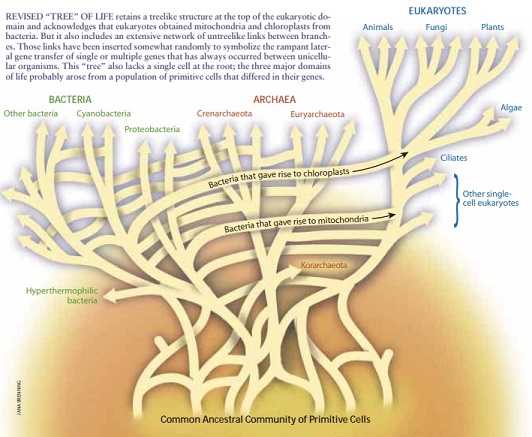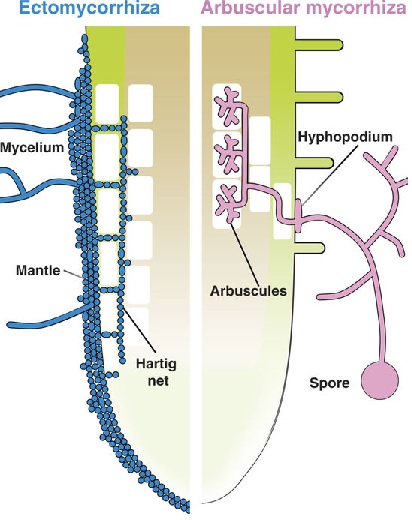Organisms
Definitions
The word "Organism" comes from the word "Organ" and the suffix "-ism". In biologic terms, "Organ" refers to a grouping of tissues into a distinct structure that performs a specialized task, such as a heart or kidney in animals or a leaf or stamen in plants. "-ism" is a suffix appearing in loanwords from Greek, where it was used to form action nouns from verbs. The term "Organism" itself has many different ways of being defined but is generally referred to as a form of life composed of mutually interdependent parts that maintain various vital processes.
History

Organisms range from basic, singular cells, to complex eukaryotes such as plants and animals. Around the time of Aristotle, scientists determined the genealogy of organisms simply by comparing their physical features to one another. This continued right up until the 1960's, at which time scientists started to create a universal phylogeny tree for every type of known organism. The tree began when two researchers, Emile Zuckerkandl and Linus Pauling of the California Institute of Technology, began basing ancestral organisms on genetic differences rather than physiology, allowing for a much more precise relation of organisms. It was then that organisms were found to be divided up into two main groups, eukaryotes and prokaryotes. During the late 1970's, a scientist by the name of Carl R. Woese discovered that by using the SSU rRNA, a small subunit ribosomal RNA, he could find the moment where organisms start to diverge and become separate entities. It was shortly after this discovery that Woese determined that not all prokaryotes could genetically be defined as bacteria, and so a third main group needed to be included, the archaea. These three main groups are still accepted today as the correct set of ancestral organisms that make up every other organism on the planet. It has recently been discovered, however, that the original three groups somehow laterally share their genes, making all organisms a conglomerate of prokaryotes, archaea, and eukaryotes. It is currently believed that the current phylogeny "tree" is some sort of interlacing web without any one definite source of original life.
Subterranean
Microorganisms such as nematodes, paramecium, and bacteria live in the soil and interact with plant organisms. Plants excrete volatile substances through their roots which are then received by the microorganisms. The microorganisms use these substances to gather information about their surroundings, and then produce their own volatile substances to communicate with each other. When the microorganisms receive the plant's substances, the microorganisms make their way over to the plant's roots to consume the extra carbon that the roots emit, as the microorganisms cannot obtain it on their own. Many different types of microorganisms can use this emitted carbon because the plant roots send it out by using multiple different chemical compounds, and some of those microorganisms will reciprocate by benefiting the plant. To benefit the plants, the microorganisms will use certain scents to dispose of excess carbon, stimulate growth, or inhibit the growth of other plants.
For example, a type of soil organism that does this are mycorrhizae. Mycorrhizae can be divided into two sub-categories called arbuscular mycorrhizal fungi, and ectomycorrhizae. Arbuscular mycorrhizal fungi (AMF) "purifies" the soil for the plants by binding any heavy metals to its fungal hyphae, and combining them with glomalin, so that the plants are unable to take up the heavy metals that would otherwise be toxic to them. The sequestration of heavy metals gives the potential for the plant to increase its tolerance to elements that could be toxic to it. Other benefits that the arbuscular mycorrhizal fungi provide to plants include increased water and nutrient collection, and greater resistance to harmful microorganisms. In order for the arbuscular mycorrhizal fungi to carry out these processes, it must first attach itself to the plant's roots. Once attached, the AMF will insert itself inside of the roots to create storage for lipids, which are then used to grow hyphae. Its next step is to send it's hyphae out into the soil as far as it can, which is approximately ten centimeters in any direction. The hyphae will then begin to take up any water and nutrients in the soil, and proceed to give the plant whatever it needs, while leaving the toxic heavy metals out. In return, the AMF will only use the excess carbon from the plant to keep itself alive.

Ectomycorrhizae (ECM) will act in the same manner as the arbuscular mycorrhizal fungi, except that it will not invade the inside of the plant. Staying completely outside of the plant's roots, ECM will extend much farther out into the soil, up to several meters long, to search for water and nutrients. By remaining outside of the root cells, the ectomycorrhizae will form a protective sheath, called a "mantle", guarding the roots from harmful microorganisms. However, the ECM will go in between the root cells and form a Hartig net in order to interact with the plant. To gather the correct nutrients that are needed for the plant, the ectomycorrhizae will specialize itself to the specific plant that it is attaching to. This means that the ECM is also able to attach to tree roots in forest ecosystems, allowing the trees and plants to interact with each other, otherwise known as the "Wood Wide Web". However, the ectomycorrhizae is limited to where it can be found. In areas where the temperature falls too low for the microorganism to survive, or where there is too little oxygen that the area is considered anoxic, it has been found that bacteria replaces the space left by the absence of ectomycorrhizae.
References
1."organism". Dictionary.com Unabridged. Random House, Inc. 18 Feb. 2018. <Dictionary.com http://www.dictionary.com/browse/organism>.
2. Doolittle, W. F. (2000), "Uprooting the tree of life" (PDF), Scientific American, 282 (6): 90–95, Bibcode:2000SciAm.282b..90D, doi:10.1038/scientificamerican0200-90, PMID 10710791, archived from the original (PDF) on 2011-01-31.
3. Wenke, Katrin, et al. “Belowground volatiles facilitate interactions between plant roots and soil organisms.” Shibboleth Authentication Request, Springer-Verlag, link-springer-com.gate.lib.buffalo.edu/article/10.1007%2Fs00425-009-1076-2.
4. Qiao, Yuhui, et al. “Effects of biochar and Arbuscular mycorrhizae on bioavailability of potentially toxic elements in an aged contaminated soil.” Shibboleth Authentication Request, 28 Aug. 2015, www-sciencedirect-com.gate.lib.buffalo.edu/science/article/pii/S0269749115300233?_rdoc=1&_fmt=high&_origin=gateway&_docanchor=&md5=b8429449ccfc9c30159a5f9aeaa92ffb.
5. Keymer, Andreas, et al. "Lipid transfer from plants to arbuscular mycorrhiza fungi." eLife, vol. 6, 2017. Health Reference Center Academic, http://link.galegroup.com/apps/doc/A500742752/HRCA?u=sunybuff_main&sid=HRCA&xid=5f36ece4. Accessed 5 Mar. 2018.
6. Mello, Antonietta, and Raffaella Balestrini. “Recent Insights on Biological and Ecological Aspects of Ectomycorrhizal Fungi and Their Interactions.” Shibboleth Authentication Request, Institute for Sustainable Plant Protection (IPSP), 15 Feb. 2018, www-frontiersin-org.gate.lib.buffalo.edu/articles/10.3389/fmicb.2018.00216/full.
7. Bonfante, Paola, and Andrea Genre. “Mechanisms underlying beneficial plant–fungus interactions in mycorrhizal symbiosis.” Nature News, Nature Publishing Group, 27 July 2010, www.nature.com/articles/ncomms1046.